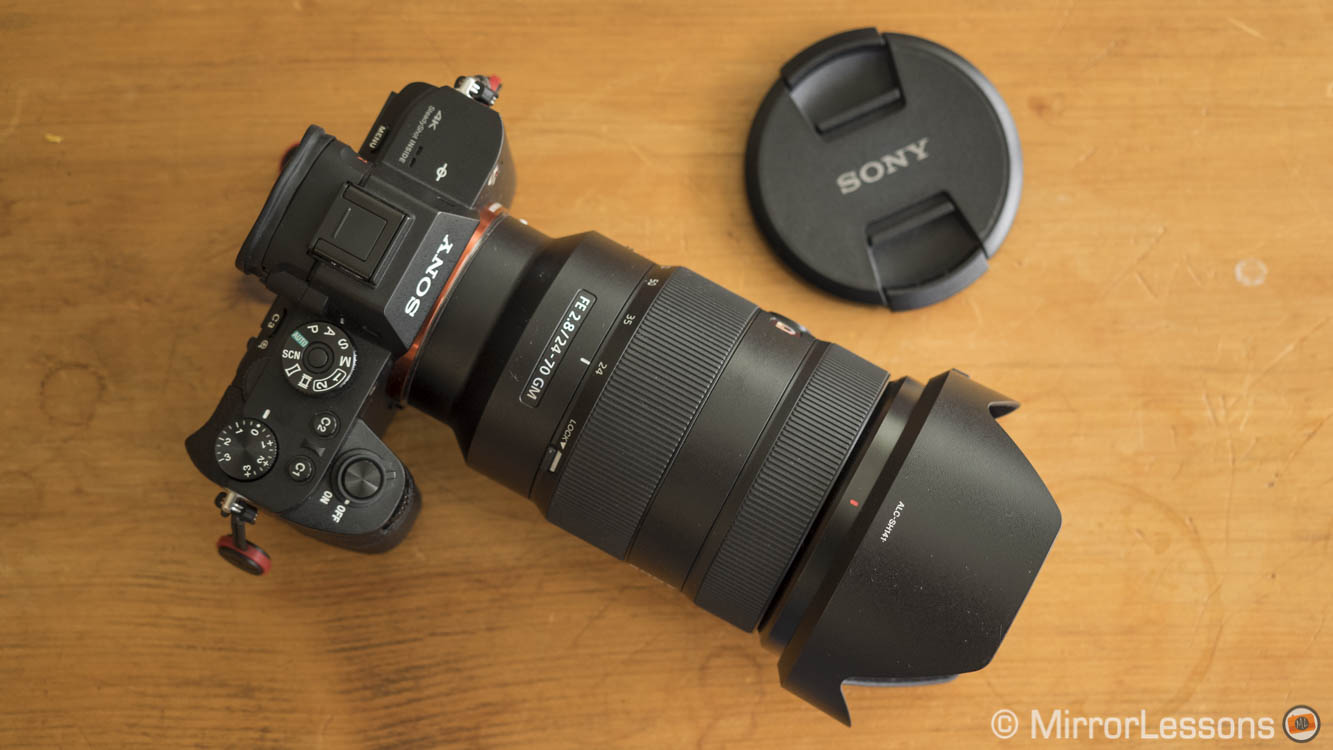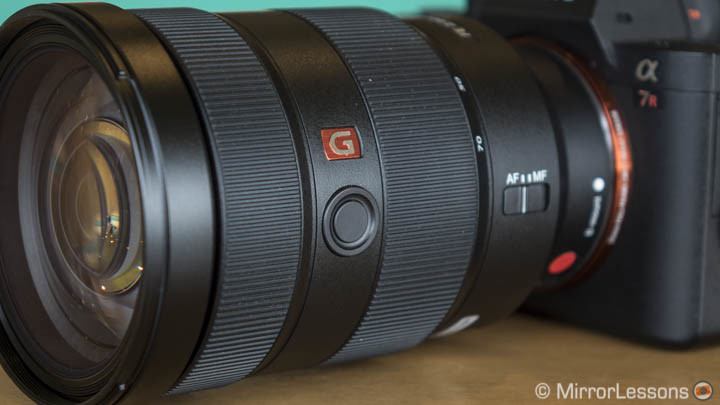I knew right from the start that reviewing this lens would not be an easy task. Would I end up rejecting it because of its size and weight or would I transcend the “mirrorless camera = small” concept and appreciate the qualities it has to offer?
I admit that it is a tough call. One of the main reasons Heather and I started this website and love mirrorless cameras so much is because of the reduced bulk and weight. Ignoring that is impossible. It would mean discarding all the praise we’ve given to “compactness” and “lightness” over the past two years.
It is not just a question of personal taste though. We’ve explained multiple times the benefits of switching from a DSLR to a mirrorless system and this Sony 24-70mm G Master lens calls for a new analysis. It’s not about pointing out the size difference anymore but rather seeing if the Sony FE system can provide relevant advantages without the compactness argument on its side.
To be totally fair, mirrorless camera systems have evolved a lot in the past two years. The size/weight argument has been put to the test multiple times and not just from Sony. This 24-70mm GM lens is perhaps the toughest “challenger” I’ve encounter so far.
Is the optical performance convincing enough to “pardon” the excessive size? Let’s find out!



Sony 24-70mm f/2.8 GM specs
- Mount: E-mount
- Format coverage: 35mm (36×24)
- Focal length: 24-70mm
- Maximum aperture: 2.8
- Minimum aperture: 22
- Number of aperture blades: 9 circular aperture blades
- Angle of view: 84 ‑ 34°
- Closest focusing distance: 38cm
- Lens configuration: 13 elements / 18 groups
- Special elements: 1 XA, 2 Aspherical, 1 Super ED and 1 ED elements
- Lens surface coating: Yes (Nano AR Coating)
- Maximum image magnification: 0.24x
- Optical Image Stabilizer: None
- Dimensions: ø87.6 x 136 mm
- Filter diamater: ø82mm
- Weight: 886g
[toc heading_levels=”3″]
Design and ease of use
Let’s get out of the way the main issue concerning this lens: we know it is large and we know it is heavy (almost 1kg). It’s not a product for those looking for a lighter combo than their full frame DSLR and 24-70mm f/2.8 lens. Being so used to my M.Zuiko 12-40mm for Micro Four Thirds, I felt as if I’d returned to DSLR territory straight away.
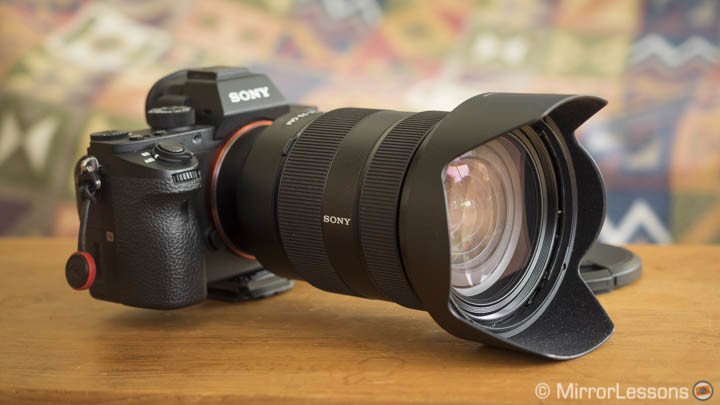
If I play the devil’s advocate here, I can say it was easy to see this coming. The Distagon FE 35mm f/1.4 (review here) is a large prime lens, as is the 90mm Macro (review here), larger than some of the DSLR equivalent products. What could we expect from a constant f/2.8 zoom lens? You can’t perform miracles when it comes to lens design and physics. When the FE system first came out, I remember lots of people lamenting the lack of lenses or that the first set of zooms were f/4 only. Now there is no more room for complaints.
In the end the answer is simple: if you want something smaller, there are other valid mirrorless systems out there.
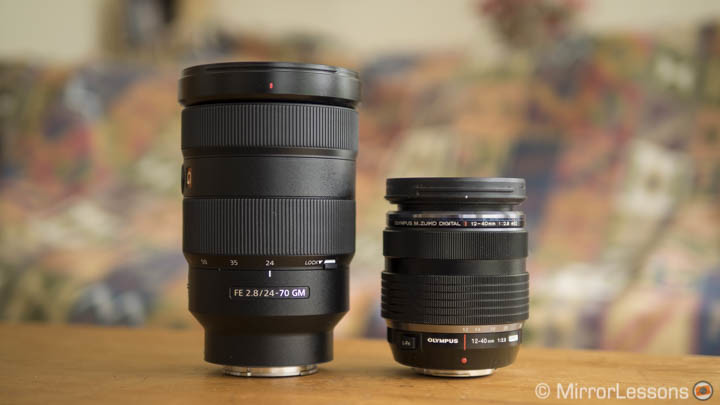
Ok, this is a little unfair but I couldn’t resist!
With this consideration out of the way, let’s concentrate on this G Master lens. The build quality is very solid (robust like a tank, I would say) but I have one criticism: such a pricey and professional lens could have come with complete weather-sealing instead of just dust and moisture resistance. Light rain won’t harm it but I am not sure up to what point it can survive harsher conditions.
Handling the camera and lens will require two hands at all times as expected. The lens is comfortable to use as far as the positioning of the rings is concerned, and there is enough grip on the barrel. It doesn’t feel too unbalanced on the A7r II but the weight is inevitably distributed toward the front.
[twentytwenty]

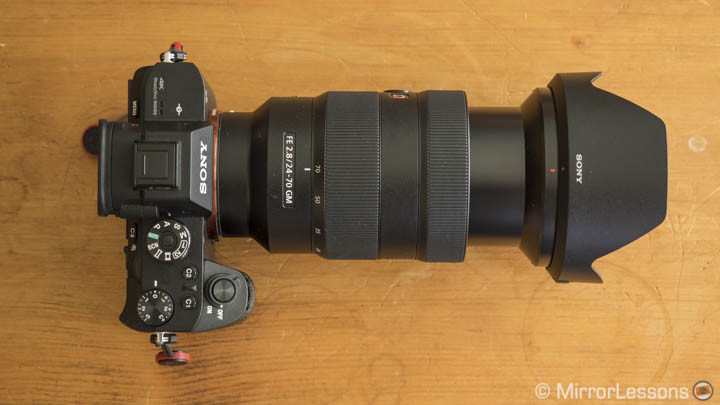
[/twentytwenty]
The zoom mechanism is not internal so the lens extends a few centimetres when you zoom in. The zoom ring is large and covered with a ribbed rubber. It is not too smooth and is actually slightly on the stiff side. That being said, framing my shot wasn’t a problem. The fact that the ring isn’t too loose means that the lens won’t extend when being carried around in a vertical orientation. It might loosen a little overtime but Sony has included a lock switch to prevent the ring from moving when set to 24mm.
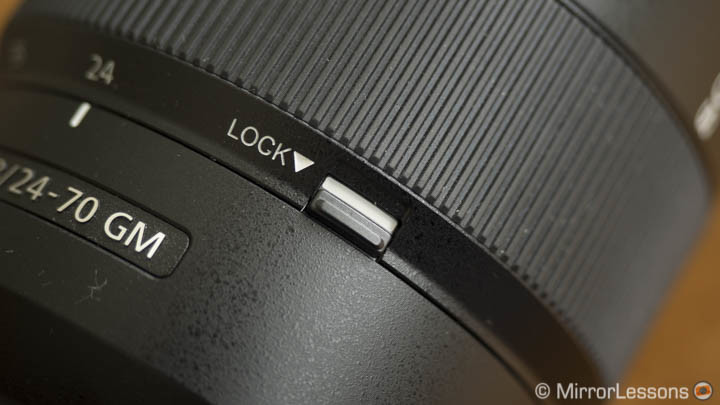
The focus ring is very smooth and I was able to fine-tune my focus point very precisely for stills (including astrophotography) and video. It is probably one of the best “focus-by-wire” type rings I’ve ever tried which confirms the sentiment I had during the press event in February. Using it with a follow focus might still prove challenging since the ring turns freely at 360° (but only a mechanical ring can fix that anyway).
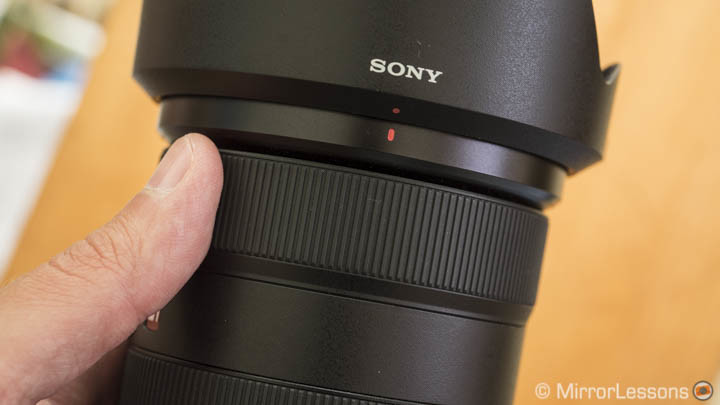
On the side of the barrel you can find an AF/MF switch and a Focus hold button. Both are comfortable to reach and use. Finally the lens hood is made of plastic and has an unlock button that lets you remove it.
Through the lens: optical quality
Sony insisted a lot on two characteristics of these new G Master lenses that are improved by the new XA (Extreme Aspherical) element introduced in the lens design. The first one is resolution and the 24-70mm doesn’t disappoint at all. Actually the results are quite remarkable.
The “weakest” (so to speak) performance is at 24mm where the optimal result is found at f/5.6 but rest assured: f/2.8 and f/4 are only slightly less sharp. The corners are almost as good as the centre.

Click on the image to open the full res version
[twentytwenty]


[/twentytwenty]
[twentytwenty]


[/twentytwenty]
At the other main focal lengths (35mm, 50mm and 70mm) centre sharpness at f/2.8 is excellent already and the best performance is found at f/4. At the corners the performance is slightly lower with the peak spot found at f/5.6.

Click on the image to open the full res version
[twentytwenty]


[/twentytwenty]
[twentytwenty]


[/twentytwenty]
From f/11 sharpness starts to decrease slightly and diffraction gets in the way from f/16. Most of the time however you will only notice it at f/22.
Overall this zoom lens performs almost as well as a high quality prime lens when it comes to resolution: that is its main strength. Landscape photographers won’t be disappointed.

Click on the image to open the full res version

Click on the image to open the full res version
The lens also performs very well wide open at 24mm for astro-photography. There isn’t any relevant trace of coma aberration. I found some slight tangential astigmatism in some other shots but it was very contained.


The second characteristic upon which Sony insisted is bokeh and indeed the 24-70mm does well in this area too. The out of focus circles are perfectly rounded and are almost free of any onion ring effect. The most pleasant performance is found at the fastest aperture of f/2.8 but the bokeh circles remain perfectly rounded even at f/8.

However the bokeh rendering can vary depending on the type of background, focus distance and focal length used. In some examples it can appear a little bit nervous especially when using a shorter focal length. Needless to say, the best performance is achieved either with the longest focal length or a short focus distance or the two combined!





The lens is appealing for occasional portraits at events or similar situations. Needless to say, you will get the best results at 70mm and f/2.8 (shallower depth of field). It won’t always give you a “wow” factor (it’s not a portrait lens after all) but does the job well and that’s all you need with this type of lens.


With this background the bokeh appears creamier and more pleasant…

…while here the look is a little more nervous (the grass was closer).
The lens can focus as close as 38cm throughout the entire zoom range giving you a magnification of 0.24x, which is okay but not the best aspect of this lens. You could find it a little bit limiting for close-ups of objects like wedding rings or similar. Close focus is another situation where the bokeh can be less attractive because of the partial double lines in the out-of-focus foreground or background.

Click on the image to open the full res version

Click on the image to open the full res version

Note some double lines in the out of focus branches.
Click on the image to open the full res version
Some barrel distortion is found at 24mm and some pincushion distortion is present at 70mm. The performance increases at the middle focal lengths of 35mm and 50mm. However all this becomes less relevant once you apply the lens profile in Lightroom or use the OOC JPGs that are automatically corrected. Make sure to have the Lens Compensation set to Auto (Second menu, page 7).
[twentytwenty]


[/twentytwenty]
[twentytwenty]


[/twentytwenty]
With the lens profile applied vignetting is negligible even at f/2.8. Chromatic aberration is well-contained but you can find traces of purple fringing is some backlit situations. You might need to remove that manually in your RAW developer software. The camera does a good job internally on the OOC JPG but it doesn’t always get rid of it completely.
[twentytwenty]


[/twentytwenty]
The most annoying flares appear where you’re not necessarily excepting them. With direct sunlight at the centre the lens resists almost perfectly. When the source of light is near the edge of the frame you can spot a discreet ghosting flare on the opposite side.

There’s a tiny green ghost flare at the centre.

Notice the reddish ghost flare on the right

With the source of light just outside the frame, veiling flare as well as a little ghost spot can appear in the image as you can see in the examples below.

Veiling flare

Veiling flare and a tiny orange ghost flare below Heather’s left eye.

Adjusting my composition slightly eliminates the veiling flare but the little orange spot remains (although it’s easily removable with Photoshop).
Autofocus performance and other considerations
The AF motor is very discreet and proved fast, reactive and reliable in most situations when mounted on the A7r II. I didn’t have any problem with Single AF or the Eye AF mode even in backlit situations.



In Continuous AF the performance remains equally good unless you are dealing with a fast subject coming towards you. In that case I find the performance slower in comparison to other FE lenses. The focus point was often slightly behind the subject.

The lens lacks image stabilisation and that can matter depending on the camera you intend to use the lens with.
For users who possess a second generation A7 camera the problem is irrelevant because you can benefit from the 5-axis in-body stabilisation. With my A7r II I managed to take a sharp shot down to 1/2s at 24mm (and even 1s when I rested my arms on a railing) and 1/5s at 70mm (with multiple attempts). As a general rule of thumb, I would say: stay around 1/5s at 24mm and 1/10s at 70mm but if you need to, you know you can push it a little more (with some patience).

Click on the image to open the full res version

Click on the image to open the full res version

Click on the image to open the full res version
For users who own a first generation A7 camera the lack of stabilisation is more annoying. Now that Sony has sensor stabilisation technology and it is likely we’ll see it on future full-frame cameras as well, I guess the company decided that it wasn’t necessary to implement it on this type of lens. It’s a shame however because the Sony image stabilisation system can take advantage of both sensor and optics systems at the same time (it uses 3 axes on the sensor and two axes on the lens).
Finally the lens can be a good asset for video if you work a lot in events or weddings where this type of zoom range and the f/2.8 aperture can prove very useful. The AF is not as fast in continuous mode with fast subjects but the quality of the lens can definitely suit video work. Note however that the large size and weight can be uncomfortable for hand-held work with some accessories or rigs you are already using. It will be too large and heavy for gimbals or small steadycams.
Conclusion
From an optical quality point of view, there is not a lot to say against this 24-70mm GM lens. Sharpness is definitely its strongest point: the results are excellent all the way through, at all focal lengths and all main apertures from corner to corner. The AF motor is fast and the distortion is contained. The bokeh can be excellent at the right distance and focal length and deliver pleasant results for casual portraits or close-ups. You can find some little traces of purple fringing but the only annoying aspect aspect really is veiling and ghost flares in certain backlit situations.
Is all this enough to consider this lens a must-have?
Well one answer is simple: this type of lens is very popular in the professional segment. There is a reason many photographers have this kind of zoom in their bag: it’s versatile, it’s fast and you easily end up using it 60/70% of the time. I certainly did, back in my DSLR days (I owned the Nikkor 28-70mm f/2.8) and later, my mirrorless days (M.Zuiko 12-40mm 2.8) as an event photographer. So if you are a pro photographer using Sony cameras, there’s a valid reason right there.

The second answer is more complicated if you are considering the Sony system for your work. Owning a “must-have” pro zoom in the FE lens catalogue is definitely positive but there is no gain in size or weight and the price is $400 higher than the Canon/Nikon equivalent. The Sony system can be attractive for other things of course like the advantage of working with an electronic viewfinder or the great video capabilities. However if these are not your main priorities (video especially), then concrete reasons to switch are more difficult to find.
I am not trying to condemn Sony for this however. They are building a system where the image quality (sensor, video, optics) is becoming the weapon of choice. They are showing the world they can be among the best and that is always positive for a young camera system. But for now, I admit I find the FE line-up more interesting with small prime lenses or a zoom like the 70-200mm f/4 as far as stills are concerned. In a way, this lens feels it has been designed for future cameras, for those products that will (hopefully) surpass DSLRs in every aspect when the main argument will be quality and not dimensions. If that day comes, then this 24-70mm will be there waiting.
Finally, the price. The lens doesn’t come cheap and is actually more expensive than the Canon/Nikon equivalent. It has the same price as the 24-70mm VR by Nikon but the latter has optical stabilisation which can somehow justify the $400 extra. There is no doubt that this G Master lens is as good as the other lenses and deserve its place on the podium. However Sony lenses always tend to be more expensive and I am not sure how relevant the difference in quality is. Since the size/weight argument no longer holds, it would have been nice to say: “hey, but the Sony is cheaper!”. Unfortunately, it’s the opposite.
 What I like about the Sony 24-70mm f/2.8 GM lens:
What I like about the Sony 24-70mm f/2.8 GM lens:
- Good build quality and excellent “fly-by-wire” focus ring
- Basically as good as top prime lenses when it comes to sharpness
- Nice bokeh rendering in most situations
- Distortion well controlled once the lens profile is applied
- Good AF performance in S-AF and Eye-AF
 Up for debate:
Up for debate:
- Size and weight will discourage those looking for a compact system (I’m one of them)
 What I don’t like about the Sony 24-70mm f/2.8 GM lens:
What I don’t like about the Sony 24-70mm f/2.8 GM lens:
- Why not have complete splash, dust and freeze resistance?
- Some veiling and ghost flares can be annoying in backlit conditions
- Some purple fringing (okay, I’m nitpicking here!)
- The lack of optical stabilisation penalizes some users
- The price can be discouraging if we compare it to other 24-70mm 2.8 lenses
